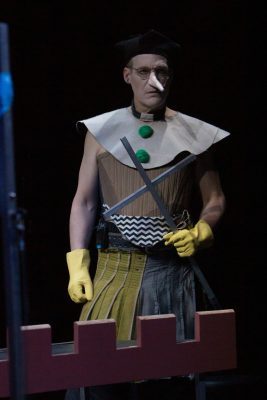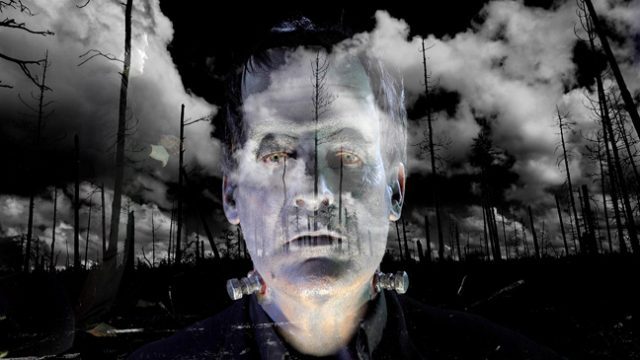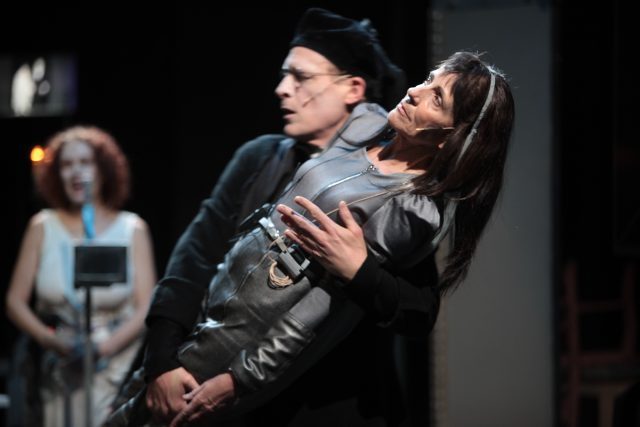
Jim Fletcher’s character goes through a transformation in A Pink Chair (photo © Hervé Veronese)
THE WOOSTER GROUP: A PINK CHAIR (IN PLACE OF A FAKE ANTIQUE)
NYU Skirball Center for the Performing Arts
566 La Guardia Pl.
January 23 – February 2, $35-$50
212-992-8484
nyuskirball.org
thewoostergroup.org
There are certain actors who just pull you in instantly; from the moment you first see them onstage, you’re hooked. For many, it might be Al Pacino or Nathan Lane, Audra MacDonald or Mary Louise Parker. Jim Fletcher is like that for a lot of intrepid, adventurous theatergoers. Tall, balding, and ruggedly handsome, the Ann Arbor native didn’t start acting until he was thirty-five, in 1998; previously he had been a teacher, a caseworker, a dogwalker, an art handler, and a pedicab driver, among other day jobs. For the past two decades he has performed extensively with some of the premier experimental theater groups in the city, most prominently Richard Maxwell’s NYC Players and Elizabeth LeCompte’s Wooster Group, in addition to collaborating with the art collective Bernadette Corporation. Among the shows Fletcher has appeared in are Elevator Repair Service’s Gatz, Maxwell’s Isolde, and Compagnie l’heliotrope’s Pollock.
A poet as well, he’s also ridiculously busy; in the past few weeks, as we conducted this interview over email, he and Sean Lewis reprised Bro-Tox at La MaMa, he stopped by the Kitchen to check out Maxwell’s latest play, Queens Row, and he’s heavy into rehearsals for the Wooster Group’s A Pink Chair (In Place of a Fake Antique), which runs at the NYU Skirball Center January 23 through February 2. The production, which was previously seen at the company’s much smaller home, the Performing Garage in SoHo, is a tribute to Polish avant-garde theater director and artist Tadeusz Kantor, with Kantor’s daughter, Dorota Krakowska, serving as dramaturg. Fletcher plays a priest; there are some funny behind-the-scenes videos on the Wooster Group’s website in which he makes a cross and plays silly word games with the cast and crew. (The cast also features Zbigniew Bzymek, Enver Chakartash, Ari Fliakos, Gareth Hobbs, Andrew Maillet, Erin Mullin, Suzzy Roche, Danusia Trevino, and Kate Valk; to find out more about the Wooster Group, the Carriage Trade Gallery on Grand St. is hosting a multimedia retrospective of the company through January 26.) Below, Fletcher discusses, in his inimitable poetic style, his dream role, working with some of the most original creators in theater, and his carpentry skills.
twi-ny: I was at a lunch party a few months ago and got into a conversation with a woman about experimental theater. She burst out about how much she loves an actor named Jim Fletcher, and we proceeded to rave about various shows we’ve seen you in. It seems you have a cult fan club out there. How does that feel?
jim fletcher: It feels great. Please elaborate! Mind you, I’m going by what you’re saying. It sounds like there’s energy bouncing around. I love that. More. Surplus. Slurplus. You know, house rules. . . . There’s energy out there in the room, I love it too, I’m devoted too. Devotion is juicy.
twi-ny: Devotion is indeed juicy. You are part of several experimental collectives that have devoted fan bases of their own, primarily the New York City Players, the Wooster Group, and Bernadette Corporation. How did you get connected with them?
jf: I’m working with people I love. It seems I never asked myself what kind of work I wanted to do, and also never the follow-up question, who best to do it with. In that sense I’m not a productive person. I think when you get close to people, you spontaneously start working in some way . . . out of sheer energy or whatever it is. Surplus.

Jim Fletcher played Frankenstein’s monster in Tony Oursler’s Imponderable (photo courtesy Museum of Modern Art)
twi-ny: What are the main differences between working with Richard Maxwell and with Elizabeth LeCompte?
jf: It’s easier for me to say what they have in common. In both cases it’s deep water, bright, alive. Like swimming in the ocean. Limitless, often extremely simple. Always big. And buoyant. Potentially dangerous because there’s power and a lot of desire. I’ve been lucky to work with them both. Ever-fresh. Always something other than what I would have imagined.
With Rich, among so many other things (ongoing), I learned the practice of active listening in the room, with your body and with your subtle body for that matter . . . whatever body you can muster. Listening to time, listening to others, to minds, listening to story and to space, without withdrawing your energy or agency, your own reasons — what can that yield, where will it go? Honestly that’s something you can pursue for as many years and hours as you have available, with audience.
With Liz I saw the whole situation get put into motion. You get a little as if your feet are off the ground. Could go in any direction at any time. Dreaming of flight. Something’s gained in translation. Movement. And she employs very complex orchestration — of lighting, sound, voice. Language. Set design. Onstage behavior. Machinery. And yes, video. All indisputably unified by the principle of a single viewpoint, that of a person watching — specifically, of her watching. It’s quite thrilling. You know sometimes as a performer in these great stage architectures of hers I simply don’t get it until I see the videotape of us trying to do it. There’s no way to really perceive it or even imagine it from onstage.
twi-ny: For a nonproductive person, you seem to work nonstop in a wide variety of genres. Among the characters you’ve portrayed over the last few years are Jackson Pollock, Jay Gatsby, and Lemmy Caution. Do you have a dream character you’d love to play?
jf: When I was first getting to know the artist Tony Oursler, he asked me that same question over coffee, “What’s your dream role?” I said “Frankenstein,” meaning, of course, Frankenstein’s monster. Seems like a year later as I was going into his studio for a few hours’ work, his assistant Jack [Colton] said to me, “I think we’ll get you into the Frankenstein makeup first.” Total surprise. Zero preparation. No time to think about it. It was so much like a dream. And my text was a song that Tony had dreamed that night, “Spark of Life.” He’d woken up and recorded it as it had come to him and I listened to it several times while Enver Chakartash and Naomi Raddatz did a genius monster makeover on me, which took all of a half hour. Frankenstein the created being. I sang it into Tony’s camera and it was strange. When I finished he pulled his face from behind the monitor; there was a tear rolling down his cheek. The tear of Frankenstein.
twi-ny: Ah, that was Imponderable, which was the centerpiece of his big MoMA show. I saw him and Constance DeJong bring back Relatives at the Kitchen two years ago. You’ve been in numerous productions at the Kitchen, as well as La MaMa, Abrons Arts Center, and the Performing Garage. For the next two weekends, you’ll be at the Skirball Center with A Pink Chair, which was previously staged at La MaMa and REDCAT in LA. Skirball is doing amazing things under Jay Wegman. What has the process been like bringing A Pink Chair there?
jf: [Skirball director] Jay Wegman makes things flow. He makes a deal spontaneously, no head-scratching, and sticks to it. Sometimes you have to sort of check yourself and say, yes, he’s really doing this. You can feel the Wegman effect when you’re working inside the institution — it was like that at Abrons too when he was there. A lot of heart. A lotta lot. He doesn’t flinch. And he seems radically relaxed somehow.
Once I was meeting with him in his office at Abrons and I casually admired this or that thing on his wall or on the desk, to which he repeatedly replied, “Do you want it?” It was very disarming and somehow a challenge. A kind of destabilizing personal bounty. I think he was serious. That’s the wild effect he has. . . . He leaves you pondering that to yourself: “I think he was serious? . . .”
twi-ny: Have there been any major adjustments to A Pink Chair given the larger stage and much bigger house?
jf: The show is feeling great in Skirball. It was conceived on a large scale, so it looks at home here. Skirball is a great space. The crowds here somehow have a kind of living room feeling . . . rather than some kind of modeled civic space. It’s a civic space that’s not trying too hard to look like one. It just is one. Very comfortable. Not obsessed with being the last word in design.
But so many of the shows I’ve seen here look great! I have noticed as an audience member here that I feel I’m able to be in contact with people sitting all the way across the room from me. Not every theater has that. Is it the curved rows? The warm array of nipple-shaped glass lamps as ceiling lighting?
As far as adjustments, we are spending a lot of time getting the sound right. That’s a major adjustment for any new venue we go to. Liz plays the room like a hi-fi set.

Jim Fletcher carries away Suzzy Roche in A Pink Chair (photo by Steve Gunther)
twi-ny: Speaking of being in the audience, when I am not in the audience watching you onstage, I often see you in the audience of other shows. What do you like to do on those rare occasions when you’re not in a theater?
jf: Burpees. Other stuff too. 🙂 Let’s spend some time together.
twi-ny: We’ll do so at Skirball, so getting back to A Pink Chair, can you talk a little about your character, the priest?
jf: About my character, I want to say up top, again: costumes by Enver Chakartash, in collaboration with Liz. When you swirl, it twirls. I have enough sense to know when a costume is doing the work for me, so I stay out of its way and let it do it.
The set is kind of like a territory, with different zones and thresholds, and a void, and a highly populated sector. In the most basic way I’d say A Pink Chair is a visit to the Underworld. A daughter (true story) engages a theater company (us) to help her go there to try to make contact with her father who was the great theater artist Tadeusz Kantor. How did we think to look there for him? That’s where he seemed to be headed in the final play he actually saw through to production, I Shall Never Return. The performers in A Pink Chair sometimes feel like pieces, subject to the zone they are in, and able to move in ways specific to each person. Mind you these are not explicit rules . . . it’s just how it has developed. Like laws of nature. What you’re seeing is a history of intelligent development . . . aimed at you, me, the unknown soldier, coming to see the show. My character the priest is one of those that is able to cross the void, for instance.
twi-ny: According to a behind-the-scenes video, it looks like you had a bit of a problem nailing your own cross; what are your carpentry skills like?
jf: I guess a crucifix is probably about the simplest thing you can make from wood. The rugged cross: Nail one piece of wood to another bisecting the smaller one, but not the larger one, at right angles. They say Christ was a carpenter. . . .